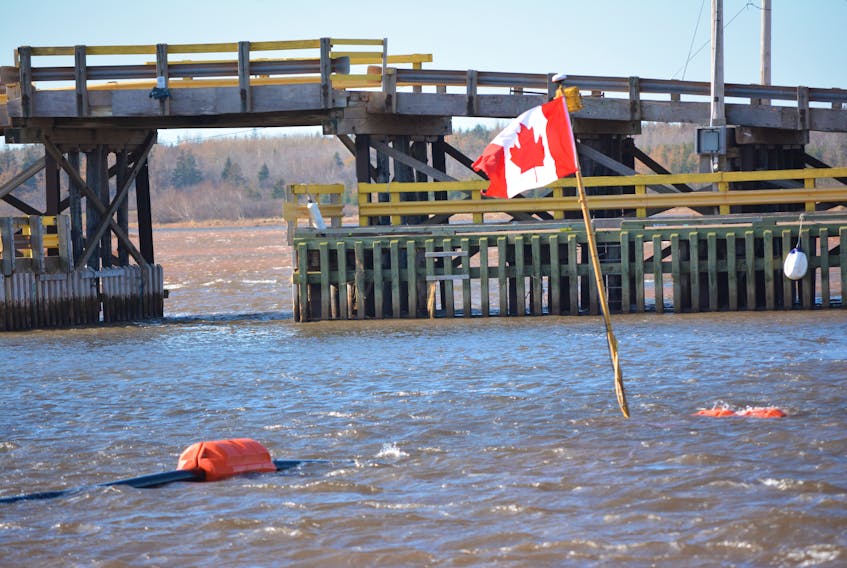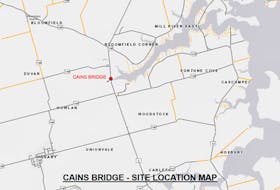SKINNERS POND, P.E.I. — A Canadian flag snaps and flaps incessantly in the stiff breeze in the middle of the Skinners Pond Harbour basin. The flag is lashed to a telescopic pole which extends out of the water at the very spot where bright orange floats bob in and out of view.
The red and white maple leaf, however, is merely for visual affect, so that a night watchman can track the progress of a robotic dredge located at the lower end of the flagpole.

Day and night, since Oct. 25, an electrically-powered dredge quietly sucked sludge from the harbour basin and pumped it through about 300 meters of pipe to a nearby settling pond. The goal is to restore the harbour’s water depth at natural low tide, to 1.8 meters.
Alberta-based Canada Pump and Power conducted the work. Set-up ran from Oct. 22 to 24 and then the diesel generator that powers the robot was switched on. It pumped upwards of 550 gallons of water and solids per minute into a settling pond.
High tension rope, attached to pulley systems on the four corners of the wharf, move this way and that to steer the underwater robotic dredge.
Danny Carlson a design engineer (EIT) with Canada Pump and Power, monitored the dredge’s operation during the day while a colleague handled the overnight shift.
The dredge operates autonomously, so no one really needs to be in attendance for it to work.
“It’s just to make sure everything moves smoothly,” Carlson explained.
He could also answer questions posed by anyone who dropped by.
The visits became less frequent as the curiosity factor wore off, Carlson admitted.
There’s also a safety consideration in having personnel in attendance as the ropes are connected to 15 horsepower pulleys on the four corners of the wharf.
The project wrapped up on Wednesday. Surveys will be conducted to determine how much sludge the robotic dredge lifted off the floor of the basin. One of the special features of the system is its ability to speed up or slow down in accordance with the feed rate.

Caleb Dyck, Canada Pump and Power’s research and development lead for the Mighty Dredge technology project, explained the company’s trek to the East Coast to showcase the technology was made possible through the Build in Canada Innovation Program.
Canada Pump and Power has been putting its technology to the test in northern and western Canada, particularly in the mining and oil and gas sectors, but this is the first time it has ventured to the east coast.
“The Canadian government gives a platform, such as this harbour, to showcase that technology on how it operates and functions and then gives you real-world feedback before you go into commercial applications,” said Dyck, noting government purchased the Mighty Dredge innovation and technology.
The Department of Fisheries and Oceans indicated by email that it is putting the Mighty Dredge through testing as a harbour basin dredging device and is in the process of determining what kind of material it is capable of moving and how it will perform in P.E.I.'s sandy sediment. The department indicated private contractors are being trained to use the device.
Dyck said local dredging contractors were at the wharf on Tuesday to examine the new technology. He admitted the company hopes the technology will be of interest to dredging companies.
“We are a service and manufacturing company. If they choose to purchase additional units from us, we will manufacture ones specific to their application.”
The demonstration model has a four-inch, 40-horsepower pump head and a six-inch HDP outlet pipe which has all the joints fused together to prevent leaks.
The company also has eight-inch and 12-inch pump heads for larger projects and can add water-jetters or agitators at the pump head for loosening packed materials.
The unit utilizes GPS and, as such, could not operate under ice, but Dyck said neither cold temperatures nor salt water are obstacles to the technology.
Skinners Pond Port Authority president Randy Doyle made several trips to check out the progress of the project.
He welcomed the first cleaning of the harbour basin in nearly two decades and said the project was timed to start only after all boats were out of the water. Boats could not be sailing through the harbour with the dredge, cables and piping in place, he noted.









